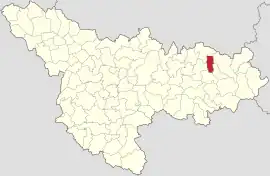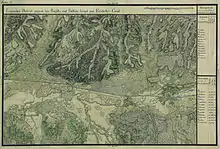Mănăștiur
Mănăștiur (Hungarian: Bégamonostor; German: Manester) is a commune in Timiș County, Romania. It is composed of four villages: Mănăștiur (commune seat), Pădurani, Remetea-Luncă and Topla. It is located in the contact area of the Lugoj Plain with the Lipova Plateau, on the upper course of the Bega River.
Mănăștiur | |
|---|---|
.jpg.webp) Wooden house in Pădurani | |
 Location in Timiș County | |
 Mănăștiur Location in Romania | |
| Coordinates: 45°50′N 22°4′E | |
| Country | Romania |
| County | Timiș |
| Government | |
| • Mayor (2020–2024) | Ionel Curuți[1] (PSD) |
| Area | 41.86 km2 (16.16 sq mi) |
| Population (2021-12-01)[3] | 1,649 |
| • Density | 39/km2 (100/sq mi) |
| Time zone | EET/EEST (UTC+2/+3) |
| Postal code | 307275–307278 |
| Vehicle reg. | TM |
| Website | www |
History

The first recorded mention of the toponym Mănăștiur dates from 1427, and in 1453 the actual settlement is recorded in the Hungarian royal documents as Monostor, located in Temes County.[4] It is very possible that this name comes from the existence of a monastery, because everywhere in Transylvania where this name was taken over by a settlement, there was a monastery. What is certain is that a fortress was built here during this period, because in 1505 the village is mentioned as castellum Monosthor.[4] The fortresses of Mănăștiur and Margina had the same captain who had taken the oath before Count Brandenburg, married to Beatrice, the widow of Matthias Corvinus.[5] For a while, Mănăștiur did not belong to either Hungary or Transylvania, which is why in 1519 an order was issued by which it was annexed to Temes County.
Mănăștiur Fortress was located north of the village, on the right bank of Bega River. In 1551 it was completely demolished by Count Petru Petrovici, who started a fight against Gheorghe Frater. A little later, in 1554, the fortress was rebuilt and the Count of Temes, Petre Popovici, reclaimed it from the leader of the Temeşvar Eyalet, Pasha Kazan. Although little is known from the Turkish occupation of Banat, Mănăștiur continued to exist, as evidenced by Marsigli's writings of 1690–1700, which speak of Monostor as part of the Făget District. The fate of the fortress is also unclear, it is not known when it was demolished, evidence of its existence being only a round ditch called by locals Mănăstire ("Monastery").[6]
After the conquest of Banat by the Austrians, in 1717, the locality is registered with 20 houses and is assigned to the Făget District.[7] In 1779, on the occasion of the re-establishment of the Krassó County, Mănăștiur was assigned to the Bulci District.
After 1880, the Hungarian authorities brought to Mănăștiur 150 families of Hungarian settlers, in a plan to Hungarianize the area, which also included several neighboring villages, including Dumbrava. The Hungarians built their houses of clay brick and formed a few alleys inhabited only by them, which run perpendicular to the main street. Some original houses of the settlers are still preserved today. In 1902 the Romanian Orthodox church was built, and in 1906 the Hungarians built a Reformed church. In the interwar period, the village was part of Plasa Balinț, Severin County.[8]
Demographics
Mănăștiur had a population of 1,658 inhabitants at the 2011 census, down 7% from the 2002 census. Most inhabitants are Romanians (89.57%), larger minorities being represented by Hungarians (3.74%) and Roma (1.81%). For 4.1% of the population, ethnicity is unknown.[9] By religion, most inhabitants are Orthodox (75.27%), but there are also minorities of Pentecostals (12.97%), Reformed (3.8%) and Roman Catholics (1.51%). For 4.76% of the population, religious affiliation is unknown.[10]
| Census[11] | Ethnic composition | |||||
|---|---|---|---|---|---|---|
| Year | Population | Romanians | Hungarians | Germans | Roma | Ukrainians |
| 1880 | 1,563 | 1,486 | 2 | 57 | – | – |
| 1890 | 1,677 | 1,620 | 3 | 30 | – | – |
| 1900 | 1,952 | 1,761 | 34 | 25 | – | – |
| 1910 | 2,287 | 1,966 | 294 | 5 | – | – |
| 1920 | 2,129 | 1,845 | 258 | 18 | – | – |
| 1930 | 2,220 | 1,776 | 238 | 18 | 181 | 1 |
| 1941 | 2,285 | 1,989 | 263 | 15 | – | – |
| 1956 | 2,464 | 2,148 | 272 | 9 | – | – |
| 1966 | 2,365 | 2,090 | 250 | 10 | – | 12 |
| 1977 | 2,094 | 1,875 | 198 | 8 | 10 | 3 |
| 1992 | 1,741 | 1,556 | 166 | 6 | 9 | 3 |
| 2002 | 1,781 | 1,597 | 104 | 3 | 52 | 25 |
| 2011 | 1,658 | 1,485 | 62 | 3 | 30 | 10 |
References
- "Results of the 2020 local elections". Central Electoral Bureau. Retrieved 16 June 2021.
- "Primăria Mănăștiur". Ghidul Primăriilor.
- "Populaţia rezidentă după grupa de vârstă, pe județe și municipii, orașe, comune, la 1 decembrie 2021" (XLS). National Institute of Statistics.
- Szabó, M. Attila (2003). Erdély, Bánság és Partium történeti és közigazgatási helységnévtára. Miercurea Ciuc: Pro-Print Kiadó.
- Pesty, Frigyes (1884). Krassó vármegye története (PDF). Vol. II. Budapest: Athenaeum R. Társ. Könyvnyomdája.
- Rădulescu, Alexandru (1980). "Cercetările de la Mănăștiur, jud. Timiș". Materiale și cercetări arheologice (14): 579–587.
- Lotreanu, Ioan (1935). Monografia Banatului. Timișoara: Institutul de Arte Grafice „Țara”.
- "Istorie". Primăria comunei Mănăștiur.
- "Tab8. Populația stabilă după etnie – județe, municipii, orașe, comune". Institutul Național de Statistică.
- "Tab13. Populația stabilă după religie – județe, municipii, orașe, comune". Institutul Național de Statistică.
- Varga, E. Árpád. "Temes megye településeinek etnikai (anyanyelvi/nemzetiségi) adatai 1880-2002" (PDF).
